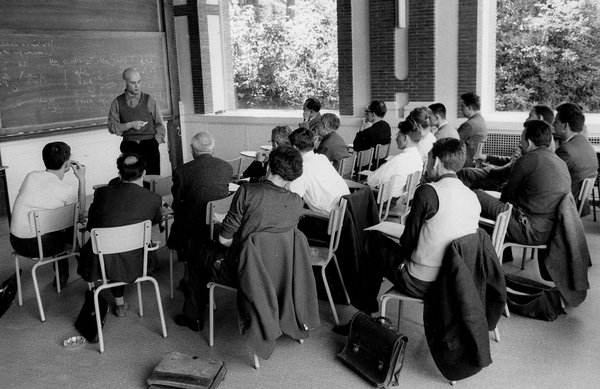
Alexander Grothendieck, who died on Nov. 13 at the age of 86, was a visionary who captivated the collective psyche of his peers like no one else. To say he was the No. 1 mathematician of the second half of the 20th century cannot begin to do justice to him or his body of work. Let’s resist the temptation to assign a number to a man of numbers. There are deeper lessons to be learned from this extraordinary human being and his extraordinary life.
In mathematics, he revolutionized the field known as algebraic geometry. Ever since Descartes, we have known that geometric shapes can be described by equations. When we write “x2 + y2 = 1,” we wish into existence a perfect circle. Indeed, each solution of this equation is nothing but a pair of coordinates, x and y, of a point of the unit circle on a plane.
This is an example of an algebraic equation, one that involves only products of powers of coordinates, such as x2 or x3y5. Since the number of coordinates can be arbitrarily large, such equations may be quite daunting. But they are fundamental, and many can be found in nature. Algebraic geometry is about them and the geometric shapes, or spaces, they describe.

Right away, one encounters a problem. The above equation gives rise to a circle only if we consider the solutions in the domain of real numbers. But there are many other domains, such as the complex numbers (which involve an imaginary number, the square root of minus 1).
One can show that the solutions of the same equation in complex numbers are points of an entirely different space; namely, a plane with one point removed. For another domain, the space of solutions could be a family of circles of different sizes: Visualize a living and breathing circle evolving in time.
Thus, for a given equation we get a whole zoo of spaces. How are they related to one another and to the equation itself? Which came first, the equation or the space? These questions had perplexed mathematicians for centuries.
Grothendieck’s genius was to recognize that there is a “being” hiding behind a given algebraic equation (or a system of equations) called a scheme. The spaces of solutions are mere projections, or shadows of this scheme. Moreover, he realized that these schemes inhabit a rich world. They “interact” with one another, can be “glued” together and so on.
The concept of a scheme was one of the cornerstones in the gargantuan effort led by Grothendieck to rebuild this vast subject. The thousands of pages meticulously composed over a decade starting in the late 1950s became commonly known as EGA and SGA, the abbreviations of their French titles. Monumental like Euclid’s “Elements,” they have not been surpassed to this day in clarity, generality, technical mastery and conceptual perfection.
They are the fruits of endless discussions, 12-hour seminars, solitary thinking — of work, in a word, for that’s what it takes: the obsessive, sustained search for truth in its most universal and abstract form. With no compromises, ever.
As Pierre Deligne, a former student of Grothendieck’s and himself a mathematical maestro, put it in Le Monde, Grothendieck “had to understand things from the most general possible point of view,” and once he achieved that, everything “became so clear that proofs seemed almost trivial.” Perhaps that’s why Grothendieck’s ideas “penetrated the unconscious of mathematicians.”
Though one might ask if there are any real-world applications of his work, the more important question is whether having found applications, we also find the wisdom to protect the world from the monsters we create using these applications. Alas, the recent misuse of mathematics does not give us much comfort.
For example, according to published reports, the National Security Agency inserted a back door in a widely used encryption algorithm based on “elliptic curves” — mathematical objects illuminated by Grothendieck’s research. Though that specific algorithm was developed much later, Grothendieck recognized the potential dangers of such misuse of math and sounded the alarm. He was incensed when he learned that IHES, the mathematics institute near Paris where he worked, received funding from the French Ministry of Defense. In protest, he resigned from the institute in 1970 at the height of his power. He had hoped that his colleagues would follow him, but none did.
So began his estrangement from the academic community, which he lambasted as lacking ethics and integrity. He refused to go to Moscow in 1966 to collect his Fields Medal, the highest award in mathematics, to protest prosecution of dissidents in the Soviet Union. He declined the prestigious Crawford Prize in 1988, calling the scientific world “fundamentally unhealthy.” He devoted himself to ecological issues long before it became fashionable, helping to found the group Survivre et Vivre, “an international movement for the survival of humanity,” in 1970.
Reading the group’s newsletter, one can see Grothendieck confronting the world’s ills with his signature rigor and passion. He fought against the injustice he saw, accepting no compromises.
A party of one, he was unafraid to be himself and to speak his truth. The man who had advanced mathematics in the most profound ways did not believe that math was the answer to everything. He taught us that life is more valuable than any equation.
This article was first published in the NY Times










